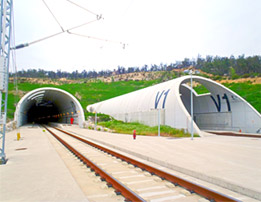
Right from antiquity, men dug into the ground to find shelter, store their crops, carry water or for many other reasons.
«The earth sciences command a body of knowledge and an armoury of techniques which together allow the nature and quality of the ground to be predicted in general terms. The intelligent use of geotechnics can then provide an account of ground characteristics for optimal planning of the project and of its form of construction. There will be intermediate phases, yielding opportunities for further eploration and observation, for the more complex or inaccessible projects.»
(abstract from "Tunnelling Technologies for the 3rd Millennium", Foreword by Sir Alan Muir Wood, ITA-AITES President 1974-1977)
Design
Tunnel design is more than a determination of the structural adequacy of component parts - it must meet practical construction requirements to secure economy and safety in a range of ground conditions.
For this purpose multiple combined disciplines are required in the design of a tunnel or underground facility : geology, geotechnique, environmental sciences, soil and rock mechanics, structure calculations, electric engineering, aeraulics or hydraulics.
Another specifity of underground facilities is even though relations may be found between them, they can not be classified into prototypes or series. The construction of each facility is a remarkable adventure as it must be driven in a particular site featuring a rock mass in no way similar to any another.
Geology
In underground works, geology affects every major decision. Any underground infrastructure will need of excavation and ulterior support of the soil or rock mass where the infrastructure is to be built.
Read moreSite investigation
Geological and hydro-geological conditions are determining factors for underground structures, having a very deep impact on the planning and budget necessary to complete the project.
Read moreGeotechnics
Geotechnical studies and investigations are a complement to geology and hydrogeology. Their objectives are to know the basic characteristics of the ground which will have an impact on the mechanical behavior of the rock or soil, the initial state of equilibrium of the natural stresses.
Read moreDesign Methods
When an underground structure is built a redistribution of the natural initial stresses takes place. Due to this redistribution, the underground structure will be subjected to a certain level of stresses and hence loads.
Read moreGround treatment
When an underground structure is to be built and the conditions of the ground are far from ideal, there are different approaches that can be followed: designing a robust support to cope with the poor characteristics of the ground.
Read moreSupport Systems
In hilly or mountainous areas, the use of tunnels improves or make feasible various tranport options uch as roads, railways, canals, etc.
Read moreEnvironment
All environmental aspects have to be studied in order to knows the environmental impacts during the life cycle of an undeground space.
Read moreMonitoring
When designing underground structures there is a large amount of uncertainty due to a large number of factors.
Read moreConstruction Methods
Conventional Tunnelling
Conventional Tunnelling can be defined as the construction of underground openings of any shape with a cyclic construction process.
Read moreMechanised Tunnelling
As opposed to conventional techniques, these are all the tunneling techniques in which excavation is performed mechanically by means of teeth, picks or disks. These tunneling techniques comprise then a wide range of different machines
Read moreSurface Tunnelling
Surface tunnelling encompasses all construction methods of underground structures built by a temporary or permanent open trench in the surface.
Read moreSubaquatic Tunnelling
Immersed tunnels have been in widespread use for about 100 years. Over 150 have been constructed all over the world, about 100 of them for road or rail schemes.
Read moreCombination of Methods
A typical example of underground structure where a combination of methods is employed is a deep base transalpine tunnel, like Gotthard and Lotschberg tunnels in Switzerland.
Read moreOperation
Equipment
Installations and equipment are an important part of underground structures. They are complex, and usually comprise a quite large part of the general budget and planning of the whole structure.
Read moreAuscultation
Several factors influence the evolution of underground facilities from their opening. Basically, they are: age, material quality, construction method,and environment, characteristics of the traffic or fluids carried.
Read moreMaintenance
Due to the high value of tunnels a good maintenance scheme must be planned for all underground structures during its life of operation
Read moreRehabilitation
Rehabilitation of an underground structure could be described as its restoration to good condition, operation, or capacity.
Read moreSafety
Safety during design stage
Before any design or planning work begins, an occupational health and safety strategy for the project should be drawn up and set out in a health and safety plan.
Read moreSafety during construction stage
Training, equipment, safety signs, fire fighting, welfare, athmospheric monitoring, lighting.
Read moreFire Safety
Following several dramatic accidents in road tunnels, between 1999 and 2001. Tunnel safety became a concern, which led to a strong demand for improvements from tunnel users and politicians.
Read more